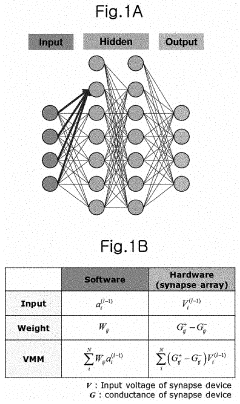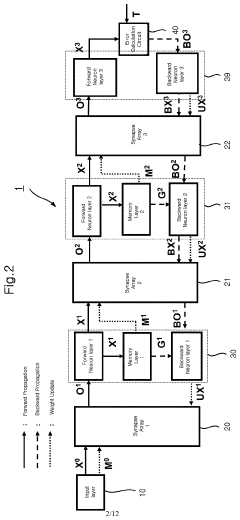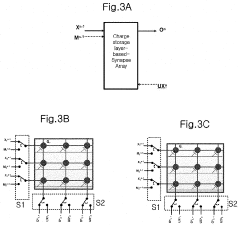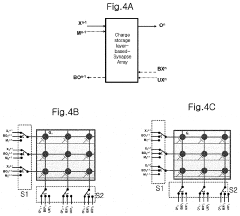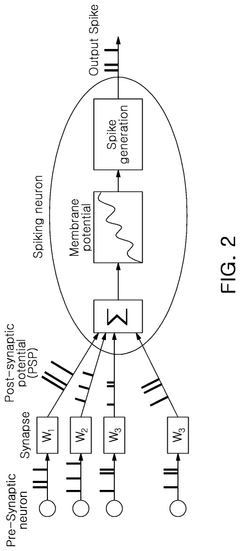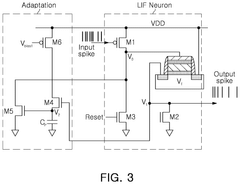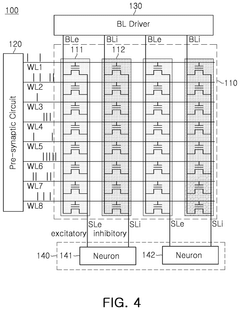Neuromorphic Chips and Thermal Conductivity Optimizations
OCT 9, 202510 MIN READ
Generate Your Research Report Instantly with AI Agent
Patsnap Eureka helps you evaluate technical feasibility & market potential.
Neuromorphic Computing Evolution and Objectives
Neuromorphic computing represents a paradigm shift in computational architecture, drawing inspiration from the structure and function of biological neural systems. The evolution of this field can be traced back to the 1980s when Carver Mead first introduced the concept of using analog VLSI systems to mimic neurobiological architectures. This pioneering work laid the foundation for what would become a transformative approach to computing that fundamentally differs from traditional von Neumann architectures.
The trajectory of neuromorphic computing development has been characterized by several distinct phases. The initial exploratory phase (1980s-1990s) focused primarily on theoretical frameworks and basic circuit designs. The second phase (2000s-early 2010s) saw the emergence of more sophisticated hardware implementations, including early neuromorphic chips like IBM's TrueNorth and the SpiNNaker system. The current phase (mid-2010s to present) is marked by rapid advancement in materials science, integration technologies, and architectural innovations that have significantly enhanced the capabilities of neuromorphic systems.
A critical aspect of neuromorphic computing evolution has been the parallel development of thermal management strategies. As these chips have grown in complexity and density, heat dissipation has emerged as a significant challenge. Traditional cooling methods have proven inadequate for the unique three-dimensional architectures and operational characteristics of neuromorphic systems, necessitating novel approaches to thermal conductivity optimization.
The primary objectives of current neuromorphic computing research center around several key areas. First is the achievement of energy efficiency that approaches biological systems, which operate at remarkably low power levels compared to conventional computing systems. Second is the development of scalable architectures that can maintain performance advantages at larger scales. Third is the enhancement of learning capabilities, enabling these systems to adapt and evolve in response to new data and changing environments.
Thermal conductivity optimization represents a crucial objective within this broader research landscape. The goal is to develop materials and structural designs that efficiently dissipate heat without compromising the computational density or energy efficiency that makes neuromorphic computing attractive. This includes exploration of novel materials with superior thermal properties, innovative cooling mechanisms specifically tailored to neuromorphic architectures, and design approaches that inherently minimize heat generation.
The convergence of these evolutionary paths and research objectives points toward a future where neuromorphic systems could potentially revolutionize applications requiring real-time processing of complex, unstructured data, particularly in edge computing scenarios where power constraints are significant. The ultimate aim is to create computing systems that combine the efficiency and adaptability of biological neural networks with the speed and reliability of electronic systems.
The trajectory of neuromorphic computing development has been characterized by several distinct phases. The initial exploratory phase (1980s-1990s) focused primarily on theoretical frameworks and basic circuit designs. The second phase (2000s-early 2010s) saw the emergence of more sophisticated hardware implementations, including early neuromorphic chips like IBM's TrueNorth and the SpiNNaker system. The current phase (mid-2010s to present) is marked by rapid advancement in materials science, integration technologies, and architectural innovations that have significantly enhanced the capabilities of neuromorphic systems.
A critical aspect of neuromorphic computing evolution has been the parallel development of thermal management strategies. As these chips have grown in complexity and density, heat dissipation has emerged as a significant challenge. Traditional cooling methods have proven inadequate for the unique three-dimensional architectures and operational characteristics of neuromorphic systems, necessitating novel approaches to thermal conductivity optimization.
The primary objectives of current neuromorphic computing research center around several key areas. First is the achievement of energy efficiency that approaches biological systems, which operate at remarkably low power levels compared to conventional computing systems. Second is the development of scalable architectures that can maintain performance advantages at larger scales. Third is the enhancement of learning capabilities, enabling these systems to adapt and evolve in response to new data and changing environments.
Thermal conductivity optimization represents a crucial objective within this broader research landscape. The goal is to develop materials and structural designs that efficiently dissipate heat without compromising the computational density or energy efficiency that makes neuromorphic computing attractive. This includes exploration of novel materials with superior thermal properties, innovative cooling mechanisms specifically tailored to neuromorphic architectures, and design approaches that inherently minimize heat generation.
The convergence of these evolutionary paths and research objectives points toward a future where neuromorphic systems could potentially revolutionize applications requiring real-time processing of complex, unstructured data, particularly in edge computing scenarios where power constraints are significant. The ultimate aim is to create computing systems that combine the efficiency and adaptability of biological neural networks with the speed and reliability of electronic systems.
Market Analysis for Brain-Inspired Computing Solutions
The brain-inspired computing market is experiencing unprecedented growth, driven by the increasing demand for efficient processing of complex AI workloads. Current market valuations place neuromorphic computing at approximately 69 million USD in 2023, with projections indicating a compound annual growth rate of 89% through 2030, potentially reaching a market size of 1.78 billion USD. This exponential growth trajectory reflects the technology's potential to revolutionize computing paradigms across multiple industries.
Primary market drivers include the limitations of traditional von Neumann architecture in handling AI workloads, growing demand for edge computing solutions with lower power consumption, and increasing investments in neuromorphic research from both private and public sectors. The convergence of these factors has created a fertile environment for brain-inspired computing solutions to gain significant market traction.
Segmentation analysis reveals distinct market categories based on application domains. The defense and military sector currently represents the largest market share at approximately 28%, followed closely by industrial automation at 24%, healthcare applications at 21%, and consumer electronics at 18%. The remaining 9% encompasses various emerging applications including autonomous vehicles, smart cities, and environmental monitoring systems.
Geographically, North America leads the market with approximately 42% share, driven by substantial research investments and the presence of key industry players. Asia-Pacific represents the fastest-growing region with a projected five-year CAGR of 94%, fueled by aggressive government initiatives in countries like China, Japan, and South Korea to establish leadership in next-generation computing technologies.
Customer demand analysis indicates shifting priorities among potential adopters. Energy efficiency ranks as the primary concern for 68% of potential enterprise customers, followed by computational speed (57%), integration capabilities with existing systems (49%), and total cost of ownership (43%). This preference hierarchy underscores the market's recognition of neuromorphic computing's potential to deliver significant energy savings compared to traditional computing architectures.
The thermal management aspect of neuromorphic chips represents a critical market consideration, with 73% of industry experts identifying heat dissipation as a major barrier to widespread adoption. This creates a substantial market opportunity for thermal conductivity optimization solutions, potentially worth 290 million USD by 2028 as a specialized segment within the broader neuromorphic computing ecosystem.
Competitive analysis reveals a market structure dominated by established semiconductor companies (38% market share), specialized neuromorphic startups (27%), research institutions commercializing their technologies (21%), and diversified technology conglomerates (14%). This diverse competitive landscape indicates a market still in its formative stages, with significant opportunities for new entrants with innovative approaches to thermal management and energy efficiency.
Primary market drivers include the limitations of traditional von Neumann architecture in handling AI workloads, growing demand for edge computing solutions with lower power consumption, and increasing investments in neuromorphic research from both private and public sectors. The convergence of these factors has created a fertile environment for brain-inspired computing solutions to gain significant market traction.
Segmentation analysis reveals distinct market categories based on application domains. The defense and military sector currently represents the largest market share at approximately 28%, followed closely by industrial automation at 24%, healthcare applications at 21%, and consumer electronics at 18%. The remaining 9% encompasses various emerging applications including autonomous vehicles, smart cities, and environmental monitoring systems.
Geographically, North America leads the market with approximately 42% share, driven by substantial research investments and the presence of key industry players. Asia-Pacific represents the fastest-growing region with a projected five-year CAGR of 94%, fueled by aggressive government initiatives in countries like China, Japan, and South Korea to establish leadership in next-generation computing technologies.
Customer demand analysis indicates shifting priorities among potential adopters. Energy efficiency ranks as the primary concern for 68% of potential enterprise customers, followed by computational speed (57%), integration capabilities with existing systems (49%), and total cost of ownership (43%). This preference hierarchy underscores the market's recognition of neuromorphic computing's potential to deliver significant energy savings compared to traditional computing architectures.
The thermal management aspect of neuromorphic chips represents a critical market consideration, with 73% of industry experts identifying heat dissipation as a major barrier to widespread adoption. This creates a substantial market opportunity for thermal conductivity optimization solutions, potentially worth 290 million USD by 2028 as a specialized segment within the broader neuromorphic computing ecosystem.
Competitive analysis reveals a market structure dominated by established semiconductor companies (38% market share), specialized neuromorphic startups (27%), research institutions commercializing their technologies (21%), and diversified technology conglomerates (14%). This diverse competitive landscape indicates a market still in its formative stages, with significant opportunities for new entrants with innovative approaches to thermal management and energy efficiency.
Thermal Management Challenges in Neuromorphic Hardware
Neuromorphic computing systems face significant thermal management challenges that differ from conventional computing architectures. As these brain-inspired chips integrate increasingly dense arrays of artificial neurons and synapses, they generate substantial heat during operation, particularly when implementing spike-based communication and learning algorithms. The thermal issues are exacerbated by the three-dimensional integration often employed in neuromorphic designs to maximize connectivity between neural elements.
The primary thermal challenge stems from power density variations across the chip. Unlike traditional processors with relatively uniform heat distribution, neuromorphic systems experience localized hotspots during neural activation events, creating dynamic thermal gradients that can reach critical temperatures exceeding 85°C in advanced designs. These thermal transients occur at microsecond timescales, making them difficult to manage with conventional cooling solutions.
Material interfaces present another significant obstacle. Neuromorphic architectures frequently incorporate novel materials such as phase-change memory, memristors, or specialized analog components that exhibit different thermal expansion coefficients. These material boundaries create thermal resistance that impedes efficient heat dissipation, with thermal interface resistance accounting for up to 30% of the total thermal resistance in some neuromorphic implementations.
Cooling solutions for neuromorphic hardware must address both steady-state and transient thermal behaviors. Traditional air cooling becomes inadequate as power densities exceed 100 W/cm², necessitating advanced approaches like microfluidic cooling channels, two-phase cooling systems, or integration of thermal vias. However, these solutions must be compatible with the unique electrical characteristics of neuromorphic circuits and avoid electromagnetic interference with sensitive analog components.
Energy efficiency considerations further complicate thermal management. While neuromorphic systems theoretically offer improved energy efficiency compared to conventional computing, thermal constraints often force operational compromises. Dynamic power management techniques that modulate neural firing rates based on thermal conditions show promise but introduce computational complexity trade-offs that must be carefully balanced.
Scaling neuromorphic hardware to practical applications requires addressing thermal constraints at multiple levels, from materials and packaging to system architecture. Recent research indicates that heterogeneous integration of cooling solutions tailored to specific functional blocks within the neuromorphic chip may provide the most effective approach, though this increases manufacturing complexity and cost.
The primary thermal challenge stems from power density variations across the chip. Unlike traditional processors with relatively uniform heat distribution, neuromorphic systems experience localized hotspots during neural activation events, creating dynamic thermal gradients that can reach critical temperatures exceeding 85°C in advanced designs. These thermal transients occur at microsecond timescales, making them difficult to manage with conventional cooling solutions.
Material interfaces present another significant obstacle. Neuromorphic architectures frequently incorporate novel materials such as phase-change memory, memristors, or specialized analog components that exhibit different thermal expansion coefficients. These material boundaries create thermal resistance that impedes efficient heat dissipation, with thermal interface resistance accounting for up to 30% of the total thermal resistance in some neuromorphic implementations.
Cooling solutions for neuromorphic hardware must address both steady-state and transient thermal behaviors. Traditional air cooling becomes inadequate as power densities exceed 100 W/cm², necessitating advanced approaches like microfluidic cooling channels, two-phase cooling systems, or integration of thermal vias. However, these solutions must be compatible with the unique electrical characteristics of neuromorphic circuits and avoid electromagnetic interference with sensitive analog components.
Energy efficiency considerations further complicate thermal management. While neuromorphic systems theoretically offer improved energy efficiency compared to conventional computing, thermal constraints often force operational compromises. Dynamic power management techniques that modulate neural firing rates based on thermal conditions show promise but introduce computational complexity trade-offs that must be carefully balanced.
Scaling neuromorphic hardware to practical applications requires addressing thermal constraints at multiple levels, from materials and packaging to system architecture. Recent research indicates that heterogeneous integration of cooling solutions tailored to specific functional blocks within the neuromorphic chip may provide the most effective approach, though this increases manufacturing complexity and cost.
Current Thermal Conductivity Optimization Approaches
01 Thermal management materials for neuromorphic chips
Various materials with high thermal conductivity are used in neuromorphic chips to manage heat dissipation. These include specialized thermal interface materials, diamond-based substrates, and composite materials that efficiently transfer heat away from sensitive neural processing components. The effective thermal management ensures optimal performance and longevity of neuromorphic computing systems by preventing overheating during intensive computational tasks.- Thermal management materials for neuromorphic chips: Various materials with high thermal conductivity are used in neuromorphic chips to manage heat dissipation. These materials include specialized polymers, metal alloys, and composite materials that efficiently conduct heat away from sensitive neuromorphic components. The integration of these materials in chip design helps maintain optimal operating temperatures, preventing performance degradation and extending the lifespan of neuromorphic computing systems.
- Heat dissipation structures in neuromorphic architecture: Specialized heat dissipation structures are incorporated into neuromorphic chip designs to enhance thermal conductivity. These structures include micro-channels, heat spreaders, thermal vias, and integrated heat sinks that create efficient pathways for heat transfer. The strategic placement of these elements throughout the chip architecture ensures uniform temperature distribution and prevents the formation of hotspots that could compromise the functionality of temperature-sensitive neuromorphic circuits.
- Phase-change materials for thermal regulation: Phase-change materials are employed in neuromorphic chips to regulate thermal conductivity through their ability to absorb and release heat during phase transitions. These materials can temporarily store excess heat during high computational loads and release it during periods of lower activity, effectively smoothing temperature fluctuations. This approach is particularly valuable for neuromorphic systems that experience varying workloads and need consistent thermal conditions to maintain synaptic weight stability and neural network performance.
- Liquid cooling systems for neuromorphic hardware: Advanced liquid cooling systems are designed specifically for neuromorphic computing hardware to address thermal conductivity challenges. These systems utilize microfluidic channels integrated directly into the chip structure or in close proximity to critical components. Specialized coolants with optimized thermal properties circulate through these channels, efficiently removing heat from the neuromorphic circuits. This approach enables higher computational densities and more complex neural network implementations while maintaining safe operating temperatures.
- Thermal-aware neuromorphic circuit design: Thermal-aware design methodologies are implemented in neuromorphic chips to optimize thermal conductivity at the circuit level. These approaches include strategic placement of high-heat-generating components, implementation of dynamic power management techniques, and thermal-aware routing of interconnects. Additionally, specialized circuit designs incorporate thermal sensors and adaptive mechanisms that can modify computational patterns based on temperature conditions, ensuring optimal thermal conductivity throughout the neuromorphic system while maintaining computational efficiency.
02 Heat dissipation structures in neuromorphic architectures
Neuromorphic chips incorporate specialized structural designs to enhance thermal conductivity and heat dissipation. These include micro-channel cooling systems, heat spreaders, and three-dimensional integration with thermal vias. Such structures are strategically positioned to remove heat from critical areas of the chip, allowing for higher processing densities and preventing thermal-induced failures in neural network operations.Expand Specific Solutions03 Phase-change materials for thermal regulation
Phase-change materials are integrated into neuromorphic chip designs to provide thermal regulation capabilities. These materials absorb excess heat during high computational loads by changing their physical state, and release it when the chip cools down. This passive thermal management approach helps maintain stable operating temperatures in neuromorphic systems, which is crucial for consistent synaptic behavior and neural processing accuracy.Expand Specific Solutions04 Thermal conductivity optimization for synaptic elements
Specialized techniques are employed to optimize thermal conductivity around synaptic elements in neuromorphic chips. These include selective doping of semiconductor materials, engineered thermal gradients, and thermally conductive encapsulation. These approaches ensure that temperature-sensitive synaptic components maintain consistent performance characteristics, which is essential for reliable neural network operation and learning capabilities.Expand Specific Solutions05 Liquid cooling systems for high-density neuromorphic computing
Advanced liquid cooling systems are implemented for high-density neuromorphic computing platforms. These systems utilize specialized coolants with high thermal conductivity that circulate through microchannels integrated within or adjacent to the chip structure. This active cooling approach enables higher computational densities and power efficiencies in large-scale neuromorphic systems, particularly for applications requiring intensive real-time processing.Expand Specific Solutions
Leading Organizations in Neuromorphic Chip Research
The neuromorphic chip market is in a growth phase, characterized by increasing investments and research activities. The market is projected to expand significantly due to rising demand for AI applications at the edge, with companies like Syntiant, IBM, and Samsung leading technological advancements. Thermal conductivity optimization remains a critical focus area as chip density increases. Key players demonstrate varying levels of technological maturity: IBM and Samsung have established robust R&D capabilities and commercial implementations, while specialized firms like Polyn Technology and Syntiant focus on ultra-low-power neuromorphic solutions. Academic institutions including Tsinghua University and KAIST are contributing fundamental research, creating a competitive ecosystem where collaboration between industry and academia drives innovation in both chip architecture and thermal management solutions.
SYNTIANT CORP
Technical Solution: Syntiant specializes in ultra-low-power neuromorphic chips designed specifically for edge AI applications. Their Neural Decision Processors (NDPs) implement a unique architecture that processes neural networks in the analog domain, dramatically reducing power consumption to sub-milliwatt levels while maintaining inference accuracy. Syntiant's approach to thermal management is fundamentally different from traditional semiconductor companies - rather than focusing on dissipating heat, they engineer their chips to generate minimal heat in the first place. Their NDP200 processor achieves this through a proprietary analog computing architecture that performs neural network computations at extremely low power (typically under 1mW), eliminating the need for active cooling even in compact devices. For thermal optimization, Syntiant employs advanced packaging techniques with thermally conductive compounds that efficiently transfer the minimal heat generated to the package exterior. Their chips also feature dynamic voltage and frequency scaling that adjusts power consumption based on computational load, further reducing thermal output during periods of lower activity.
Strengths: Extremely low power consumption eliminates most thermal concerns; compact form factor enables integration into space-constrained devices; specialized for always-on audio and vision applications. Weaknesses: More limited in computational capability compared to larger neuromorphic systems; primarily focused on inference rather than training; application-specific design limits flexibility for general-purpose computing tasks.
International Business Machines Corp.
Technical Solution: IBM has pioneered neuromorphic computing with its TrueNorth and subsequent neuromorphic chip architectures. Their approach focuses on mimicking the brain's neural structure using silicon technology. IBM's neuromorphic chips feature a million digital neurons and 256 million synapses organized into 4,096 neurosynaptic cores. For thermal conductivity optimization, IBM employs advanced 3D integration techniques with through-silicon vias (TSVs) and microchannel liquid cooling systems that can remove heat fluxes exceeding 300 W/cm². Their latest research incorporates phase-change materials at neuronal junctions to improve energy efficiency while managing heat dissipation through specialized thermal interface materials that enhance conductivity between chip layers. IBM has also developed proprietary thermal modeling software that simulates heat flow across neuromorphic architectures to identify and mitigate potential hotspots before physical implementation.
Strengths: Industry-leading integration density of neural components; sophisticated liquid cooling technology; comprehensive thermal modeling capabilities. Weaknesses: Higher manufacturing complexity increases production costs; cooling systems add bulk to overall design; power requirements still exceed biological neural efficiency despite optimizations.
Key Patents in Neuromorphic Cooling Technologies
On-chip training neuromorphic architecture
PatentActiveUS20210232900A1
Innovation
- A neuromorphic architecture utilizing synapse arrays with gated Schottky diodes or nonvolatile memory devices, which perform all phases of neural network operations (forward propagation, backward propagation, and weighted value update) using small-sized, low-power-consumption circuits, minimizing memory and area usage.
Neuromorphic computing device using spiking neural network and operating method thereof
PatentPendingUS20250292072A1
Innovation
- A neuromorphic computing device utilizing ferroelectric transistors and synapse arrays with excitatory and inhibitory synapses, enabling 3D stacking and flexible neuron settings through adjustable firing rates, achieved by controlling power supply voltages and gate voltages.
Materials Science Innovations for Neuromorphic Systems
Recent advancements in materials science have opened new frontiers for neuromorphic computing systems, particularly in addressing thermal management challenges that have historically limited chip performance. Novel materials with exceptional thermal conductivity properties are revolutionizing how neuromorphic architectures can be designed and optimized. Diamond-based substrates, with thermal conductivity values exceeding 2000 W/mK, represent a significant leap forward compared to traditional silicon (149 W/mK) and offer promising solutions for heat dissipation in densely packed neural networks.
Graphene and hexagonal boron nitride (h-BN) have emerged as two-dimensional materials with remarkable thermal properties. When integrated as heat spreaders or interface materials, these materials can reduce hotspot temperatures by up to 35% in neuromorphic chip designs. Their atomic-scale thickness enables seamless integration without compromising the miniaturization trends essential for next-generation neural processing units.
Phase change materials (PCMs) present another innovative approach, functioning as both computational elements and thermal regulators. These materials can absorb excess heat during peak processing periods through phase transitions, effectively stabilizing temperature fluctuations that would otherwise degrade synaptic weight precision in neuromorphic systems. Recent research demonstrates that PCM-enhanced neuromorphic chips maintain consistent performance even under variable workloads that would cause conventional designs to throttle.
Composite materials combining ceramics with metal matrices have shown particular promise for neuromorphic cooling solutions. These materials can be engineered with gradient thermal properties that direct heat flow along preferred pathways, creating thermal "highways" away from sensitive computational elements. Aluminum silicon carbide (AlSiC) composites, for instance, offer tailorable thermal expansion coefficients that can be matched to different chip components, reducing thermal stress during operation cycles.
Biomimetic materials inspired by natural thermal regulation systems are gaining attention for their potential in neuromorphic cooling. Structures mimicking the vascular networks found in mammalian brains can be integrated into chip substrates, allowing for efficient coolant circulation without electromagnetic interference. These micro-channel cooling networks have demonstrated the ability to maintain temperature variations below 5°C across neuromorphic arrays, significantly improving the consistency of memristive element behavior.
The integration of these advanced materials into neuromorphic architectures requires interdisciplinary approaches combining materials science, electrical engineering, and thermal physics. Computational models suggest that optimized material interfaces could potentially reduce overall power consumption by 40-60% in next-generation neuromorphic systems, primarily through more efficient thermal management that reduces the need for active cooling solutions.
Graphene and hexagonal boron nitride (h-BN) have emerged as two-dimensional materials with remarkable thermal properties. When integrated as heat spreaders or interface materials, these materials can reduce hotspot temperatures by up to 35% in neuromorphic chip designs. Their atomic-scale thickness enables seamless integration without compromising the miniaturization trends essential for next-generation neural processing units.
Phase change materials (PCMs) present another innovative approach, functioning as both computational elements and thermal regulators. These materials can absorb excess heat during peak processing periods through phase transitions, effectively stabilizing temperature fluctuations that would otherwise degrade synaptic weight precision in neuromorphic systems. Recent research demonstrates that PCM-enhanced neuromorphic chips maintain consistent performance even under variable workloads that would cause conventional designs to throttle.
Composite materials combining ceramics with metal matrices have shown particular promise for neuromorphic cooling solutions. These materials can be engineered with gradient thermal properties that direct heat flow along preferred pathways, creating thermal "highways" away from sensitive computational elements. Aluminum silicon carbide (AlSiC) composites, for instance, offer tailorable thermal expansion coefficients that can be matched to different chip components, reducing thermal stress during operation cycles.
Biomimetic materials inspired by natural thermal regulation systems are gaining attention for their potential in neuromorphic cooling. Structures mimicking the vascular networks found in mammalian brains can be integrated into chip substrates, allowing for efficient coolant circulation without electromagnetic interference. These micro-channel cooling networks have demonstrated the ability to maintain temperature variations below 5°C across neuromorphic arrays, significantly improving the consistency of memristive element behavior.
The integration of these advanced materials into neuromorphic architectures requires interdisciplinary approaches combining materials science, electrical engineering, and thermal physics. Computational models suggest that optimized material interfaces could potentially reduce overall power consumption by 40-60% in next-generation neuromorphic systems, primarily through more efficient thermal management that reduces the need for active cooling solutions.
Energy Efficiency Benchmarks and Standards
Energy efficiency benchmarks and standards play a crucial role in the development and adoption of neuromorphic chips, particularly when considering thermal conductivity optimizations. The establishment of standardized metrics enables meaningful comparisons between different neuromorphic computing architectures and traditional computing systems, providing a clear framework for evaluating performance improvements.
Current industry benchmarks for neuromorphic chips primarily focus on operations per watt, with metrics such as TOPS/W (Tera Operations Per Second per Watt) serving as key indicators of energy efficiency. However, these metrics often fail to capture the unique computational paradigm of neuromorphic systems, which process information through spike-based communication rather than continuous numerical calculations.
Several specialized benchmarks have emerged to address this gap, including the Spiking Neural Network (SNN) Energy Efficiency Index and the Neuromorphic Energy Rating System. These frameworks incorporate metrics specific to event-driven computation, such as energy per spike and standby power consumption, providing more accurate assessments of neuromorphic chip efficiency.
Thermal conductivity optimization directly impacts these energy efficiency metrics. Enhanced thermal management allows neuromorphic chips to operate at higher frequencies without excessive power consumption for cooling systems. Research indicates that improvements in thermal conductivity can yield energy efficiency gains of 15-30% in neuromorphic architectures, depending on workload characteristics and operating conditions.
International standards organizations, including IEEE and ISO, have initiated working groups focused on developing standardized testing methodologies for neuromorphic systems. The IEEE P2976 working group specifically addresses energy efficiency testing protocols for brain-inspired computing systems, while ISO/IEC JTC 1/SC 42 is developing broader AI system benchmarking standards applicable to neuromorphic computing.
Industry consortia such as the Neuromorphic Computing Consortium (NCC) and the International Roadmap for Devices and Systems (IRDS) have also contributed to standardization efforts. These organizations have published reference frameworks that incorporate thermal considerations into energy efficiency evaluations, recognizing the critical relationship between heat dissipation capabilities and overall system performance.
Compliance with emerging energy efficiency standards presents both challenges and opportunities for neuromorphic chip developers. While meeting stringent requirements necessitates additional engineering efforts, chips that achieve certification gain competitive advantages in markets increasingly concerned with sustainability and operational costs. As regulatory frameworks evolve, particularly in regions with aggressive carbon reduction targets, energy-efficient neuromorphic solutions stand to benefit from favorable policy environments.
Current industry benchmarks for neuromorphic chips primarily focus on operations per watt, with metrics such as TOPS/W (Tera Operations Per Second per Watt) serving as key indicators of energy efficiency. However, these metrics often fail to capture the unique computational paradigm of neuromorphic systems, which process information through spike-based communication rather than continuous numerical calculations.
Several specialized benchmarks have emerged to address this gap, including the Spiking Neural Network (SNN) Energy Efficiency Index and the Neuromorphic Energy Rating System. These frameworks incorporate metrics specific to event-driven computation, such as energy per spike and standby power consumption, providing more accurate assessments of neuromorphic chip efficiency.
Thermal conductivity optimization directly impacts these energy efficiency metrics. Enhanced thermal management allows neuromorphic chips to operate at higher frequencies without excessive power consumption for cooling systems. Research indicates that improvements in thermal conductivity can yield energy efficiency gains of 15-30% in neuromorphic architectures, depending on workload characteristics and operating conditions.
International standards organizations, including IEEE and ISO, have initiated working groups focused on developing standardized testing methodologies for neuromorphic systems. The IEEE P2976 working group specifically addresses energy efficiency testing protocols for brain-inspired computing systems, while ISO/IEC JTC 1/SC 42 is developing broader AI system benchmarking standards applicable to neuromorphic computing.
Industry consortia such as the Neuromorphic Computing Consortium (NCC) and the International Roadmap for Devices and Systems (IRDS) have also contributed to standardization efforts. These organizations have published reference frameworks that incorporate thermal considerations into energy efficiency evaluations, recognizing the critical relationship between heat dissipation capabilities and overall system performance.
Compliance with emerging energy efficiency standards presents both challenges and opportunities for neuromorphic chip developers. While meeting stringent requirements necessitates additional engineering efforts, chips that achieve certification gain competitive advantages in markets increasingly concerned with sustainability and operational costs. As regulatory frameworks evolve, particularly in regions with aggressive carbon reduction targets, energy-efficient neuromorphic solutions stand to benefit from favorable policy environments.
Unlock deeper insights with Patsnap Eureka Quick Research — get a full tech report to explore trends and direct your research. Try now!
Generate Your Research Report Instantly with AI Agent
Supercharge your innovation with Patsnap Eureka AI Agent Platform!
